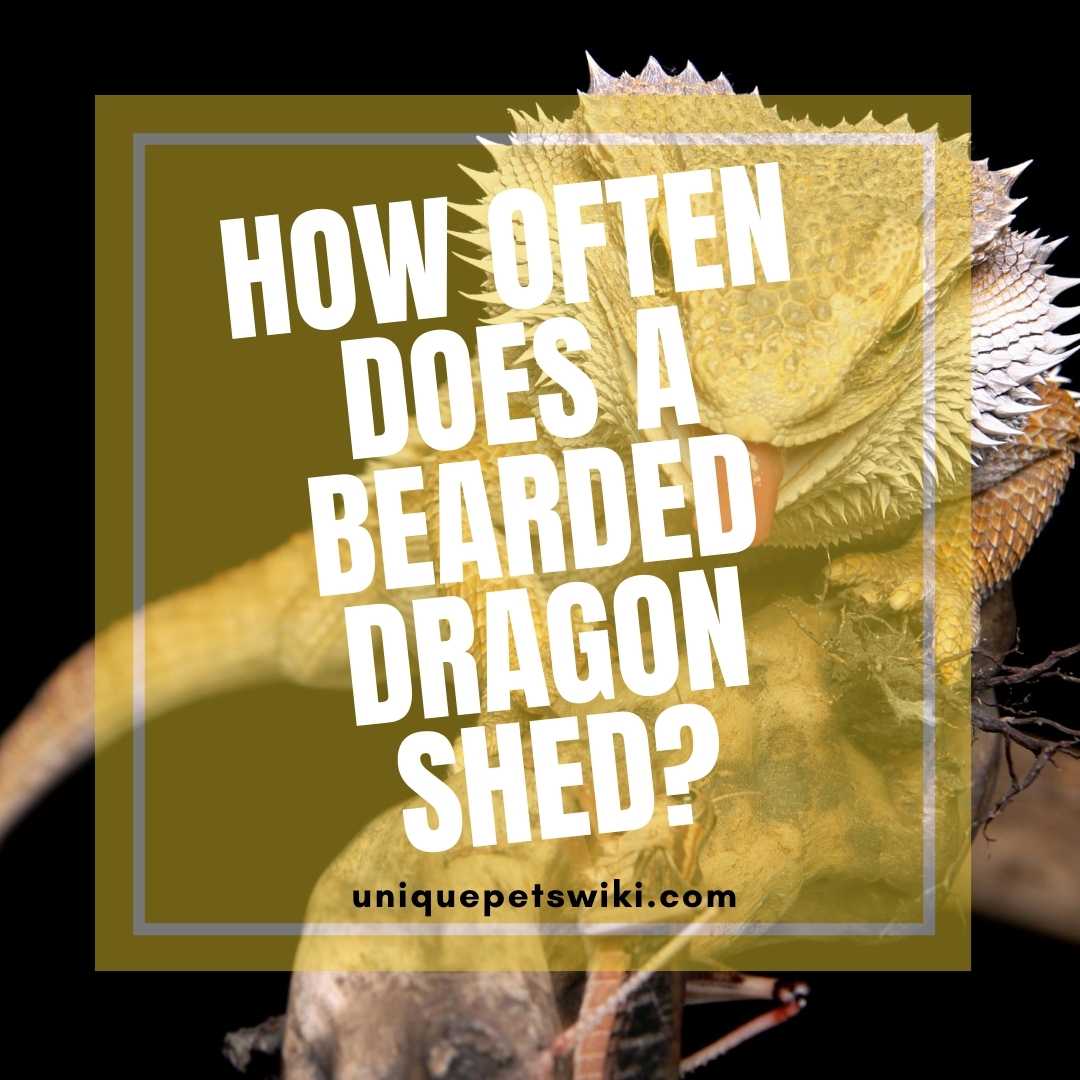Shedding or molting is a natural process that occurs in reptiles to enhance growth. Here, we’ll learn how often a bearded dragon shed, and what to expect.
How often a beardie will shed varies from the young dragons to adults since they have different growth rates. A beardie can delay shedding and this brings a lot of concerns to many people, and that’s why they are curious to know how often the dragons shed.
Also, another problem comes in where many bearded dragon owners do not know what to expect after the shedding process is complete.
Further in the article, I will talk about the shedding process in pet beardies, how long it lasts, health issues associated with shedding and more.
This article has been reviewed by Dr. Dilber. Read more about our knowledge control process here.
Contents
Understanding Shedding in Bearded Dragons
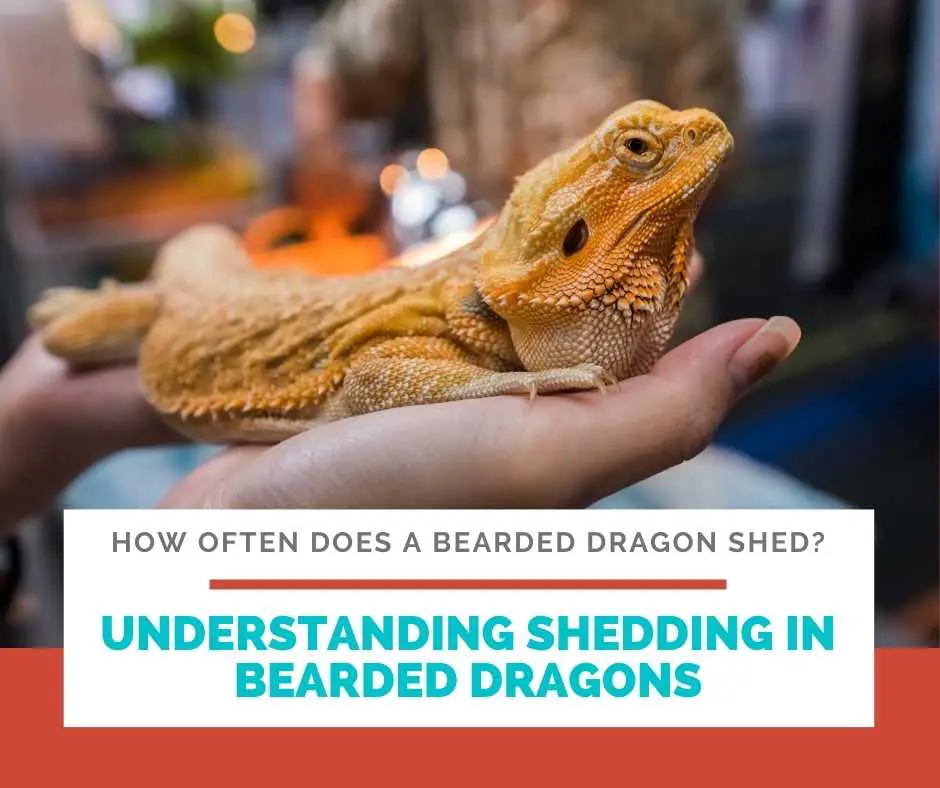
Scientifically, the shedding process in reptiles is called ecdysis. It is a complex process where the old skin that’s dead need to be replaced with a new layer for specific purposes. A new epidermis grows underneath the old skin, and therefore, the beardies have to cast off the old skin.
Immediately the new skin is fully formed, the beardie starts to release enzymes responsible for separating the new layer from the old skin. The enzymes will detach the two layers, and shedding starts from specific parts.
Unlike snakes that will cast off their skin at once, shedding in bearded dragons happens quite differently. Each part, including the head, chin, thighs, belly, back, and tail, will discard separately. Also, the process can go for several days, weeks or even months.
The new skin is more effective at taking in UVB and Converting vitamin D to D3. For a successful shedding process, the beardie must be subjected in a more humid environment.
There is no specific time when a beardie should start sloughing; it varies depending on how fast your beardie is growing and its age.
Do Bearded Dragons Shed?
All reptiles, including bearded dragons, must undergo the shedding process as long as they are growing. The primary reason for shedding is to renew the old skin that consists of the dead tissues.
While the primary thing that triggers shedding in beardies is growth, other factors that can initiate this process are diet, brumation, breeding, humidity, temperature, health, stress, etc.
Bearded dragons do shed, and it is crucial for any person owning these fascinating pets to understand everything that entails shedding in the beardies. This will help you to know all the do’s and don’ts and what to expect after the molting process is over.
Most of the time, the beardies go through shedding without needing any kind of help. However, sometimes, there are things you can do to enhance smooth and more comfortable shedding. To be able to help out, you must understand shedding requirements.
Why Do Bearded Dragons Need to Shed?
As we have seen, shedding is a natural process and is significant in reptiles. Bearded dragons will molt because they are growing, and when they want to replace the damaged skin.
The old skin of the bearded dragons becomes hard and does not stretch, so they replace this non-stretchable skin with a new flexible one.
Many signs will help you to know when your beardie pet is shedding, but we are going to see them further in the article.
Here is a detailed discussion of why a bearded dragon needs to shed. Continue reading to learn more.
Bearded Lizards Sloughing Due to Growth
The way adult lizards will shed is not the same as the babies and juveniles. Baby dragons molt more often than the adults. This means that as the beardies grow, the frequency of shedding declines.
Beardies between 0-6 months old.
Baby dragons are in their initial growing stage, and therefore, they are growing profusely, and their skin cannot keep up. Because of the rapid growth, the beardie at this age bracket will need to shed more frequently.
A bearded dragon between 6-12 months
Young dragons in this age are called juveniles and are growing pretty less often than the babies below five months. Due to reduced growth, shedding slightly goes down.
Shedding also depends on the hormonal balance of the body. As it changes with age.
A bearded lizard that is 12 months old
At one year old, the bearded lizards tend to grow much slower because most of the body parts are almost fully developed. Thus, shedding declines significantly, and the dragon can shed a few times in the whole year.
At 18 months old and above
A bearded dragon that is 18 months old is already mature and has reached its maximum growing size. So, the shedding will not be due to growth but other things
Don’t panic if shedding becomes something rare with your bearded dragon when it reaches one and a half years; it is normal. Another thing that you will notice at this stage is that shedding happens in random patches.
Shedding Due to Damaged Skin
A bearded dragon will need to cast off a skin that is damaged and replace it with a fresh protective layer.
You may be wondering how your pet’s skin can get damaged, but it can happen due to a couple of reasons. For instance, if your pet rubs itself against a hard surface, it can get injuries.
However, the most common cause of damage in a dragon’s skin is parasites. Presence of parasites causes irritation, and this may be the reason why the beardie is rubbing against the object. Parasites also suck blood and cause bruises on the skin.
What Does Shedding in a Bearded Dragon Look Like?
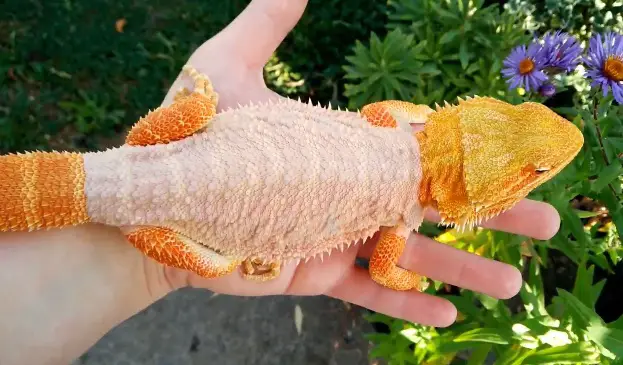
(Source: Meet Marmaduke YouTube)
When it is time to shed, typically, bearded dragons mostly don’t behave as usual. Some tend to be aggressive and defensive when you try to pick them up. The body color also tends to change to dull grayish or white.
If you see these behaviors in your lizard, it is entirely normal, and you don’t need to worry. The beardie is looking forward to shedding.
Other signs of pre-shedding are lethargy, eyes bulging out, loss of appetite, and skittish behavior.
Also, when the beardies are already shedding, you will see them scratching their bodies persistently with legs, and frequent rubbing against rough surfaces, branches or rocks.
How Long Will It Take for a Bearded Dragon to Finish Shedding?
How long the shedding process will last depend primarily on the age of your bearded dragon. Some beardies will shed in portion, and others have to molt the full body. The latter one takes quite a long time to finish while shedding in parts is much shorter.
Let’s see how long the shedding process lasts in different stages of bearded dragons.
Baby Bearded Dragons
Just to repeat what I mentioned above, baby dragons are growing at a high rate, and shedding is habitual.
They shed almost every week and so; shedding lasts only for a few days.
Juvenile Bearded Dragons
Juvenile bearded dragons are still growing but not as fast as the babies. Shedding can take a couple of weeks before it is accomplished.
Unlike the babies, shedding is random with the juveniles. Perhaps, a beardie will shed the body first, and after a week a shed on the head.
Adult Bearded Dragons
A beardie that is one year old and above is considered to be an adult. The adults will shed infrequently, and the number keeps on reducing as the beardie ages from 12 months and above.
Also, shedding happens periodically; for instance, if the beardie starts by molting its body, the head may be shed even after a couple of weeks.
How Often Does a Bearded Dragon Shed?
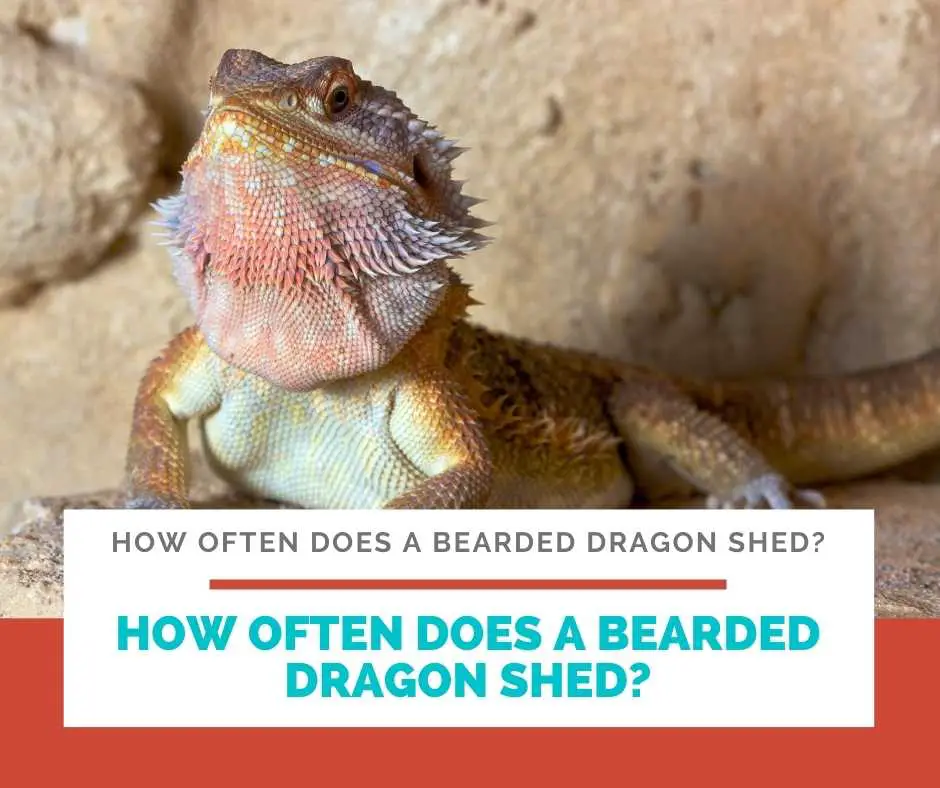
How many time bearded dragons shed per year depends on the age of your beardies.
Baby bearded dragon will shed every week while a juvenile will shed twice/month. For an adult bearded dragon, they usually shed 2 – 3 times per year. Mean every four months.
After your beardie reached the adult stage, you can see they less shed than the young ages.
Vet comment: Shedding has not a specific limit. It can vary with the health, age, and genetic status of the bearded dragon.
Baby Bearded Dragons
The babies that are below two years old grow more rapidly, and they also molt more often when compared to juveniles and adults.
The beardie babies can go through the shedding process once every week or after a few weeks. At about six months, you will notice that shedding frequency will start reducing. Shedding in babies happens basically due to growth.
Juvenile Bearded Dragons
Juvenile beardies are also growing but not as quickly as babies. Their growth rate slows down a bit, and this reduces the frequency of shedding.
So, the juvenile beardies will molt about two times a month at most. When it keeps aging, from seven months, the beardie can shed once in a month.
However, it is also possible for the juveniles to molt even after three months, and this continues until they are about to become adults.
Adult Bearded Dragons
You can go for several months before noticing any signs of shedding in adult bearded lizards, and this can bother you a lot. In adults, shedding is uncommon, and it can happen probably once or a couple of times per year.
As long as your pet does not express any complications with its health, there is nothing to make you worry.
Health Issues During Shedding You Need to Know
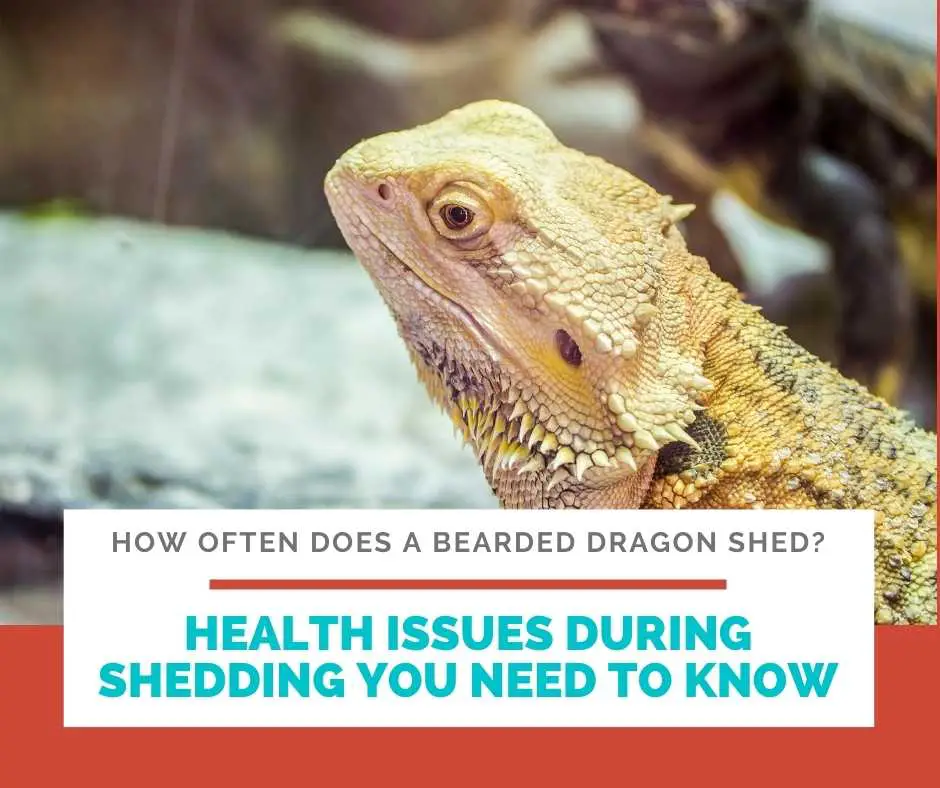
Sometimes, if the shedding does not happen successfully, it can always result in health issues that can be of great concern. If you notice that your pet is not shedding correctly, there might be a problem.
It is always important not only to understand about shedding in bearded dragons but also any potential risks associated with this critical process. Here are some of the health issues during shedding that you need to be aware of them.
Dysecdysis
Dysecdysis sometimes referred to as genetic but is rare.
Dysecdysis is a medical term, and in simple words, it is called retained shed. It happens when the old skin does not molt reasonably. If a beardie has retained shed, you can see a dead and dull skin in the areas that did not shed.
The body parts such as limbs, tail, toes and spikes can create big problems if they retain a shed. These are the first parts to check for dysecdysis because if they are affected, they lose circulation more quickly and eventually appear dull.
Lack of blood flow in these essential body parts can be pretty dangerous, and if the problem is severe, they can even rot away.
A retained shed can be due to poor husbandry practices. You’ll need to check if the conditions in the enclosure are right and if there’s any change with the diet.
If you feel that your pet has retained shed especially in the areas mentioned above, if possible, you can apply some aloe vera 1-2 times daily. But if you have worries, make sure to involve a qualified reptile vet.
Difficulty Walking
If you think that your pet has a problem with moving and it has recently come out of shedding, you will need to check for a shed.
Due to improper shedding, some old skins are retained in some body parts like the legs. The dead skin that did not molt will in the end shrink, becomes tight and then cuts off the circulation of blood.
The feet that are affected become numb at first and the beardie seems to walk unexpectedly. The best way to correct difficulty in walking is informing your reptile vet, but you can also apply aloe vera where you see the retained shed.
Tail Rot
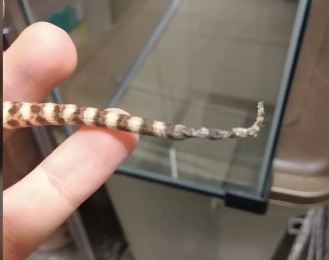
Tail rot can be fatal in bearded dragons, and it happens due to a variety of factors, but I’m going to focus on shedding. So, tail rot is a common problem, mainly when there is continuous and improper shedding.
If the tail does not shed and it happens repeatedly, the old skin remaining behind shrinks and prevents the flow of the blood to the tail. A tail tip experiencing such a problem will not only grow but also become rotten.
A beardie that is suffering from tail rot, its tail appears darker at the tip and remains like that even when shedding is complete.
To prevent tail rot in your pet, you need to keenly observe your beardie frequently and check for any constriction on the tail tip. You can choose to bath the beardie regularly, soak the tail in warm water, and apply olive oil but be sure to cover it.
Yellow Fungus
Yellow fungus is a severe fungal infection that affects the superficial layer and the deep tissues, and in extremity, it can attack the body organs. The scales lose their color and become yellow.
If a bearded dragon has a yellow fungus, the shedding will be beyond the expectation. Also, you may observe thick and hard scaly patches. Yellow fungus, if it has already developed, will need a reptile vet to intervene.
However, the most important thing is to keep an eye on your pet and check for any changes regularly. Early detection of yellow fungus will help you to act fast and keep it under control.
Wrapping Up
There you have it; I hope that this article on how often a bearded dragon shed has helped you. The bearded dragon shedding process is not complicated, and it happens countless times, but it all depends on the age of the beardie.
Most of the time, bearded dragons don’t usually need any help when they are shedding. But it is vital if you can understand shedding and what to do when your pet requires your help. Shedding is a natural process in bearded dragons like any other.
